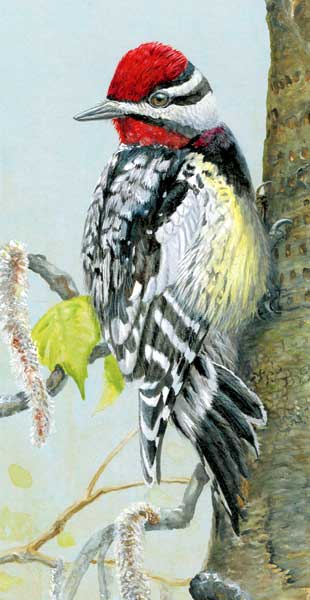|
 Yellow-bellied
Sapsucker Yellow-bellied
Sapsucker
by Barry Kent MacKay
A mature male yellow-bellied sapsucker.
Illustration by Barry Kent MacKay
In the latter half of the 1950s
there was an American TV show called the Bob Cummings Show.
It starred Robert Cummings as photographer Bob Collins, and
co-starred Nancy Kulp as an insufferably nerdy, pompous and
flighty, khaki-clad birdwatcher by the hoity-toity name of
Pamela Livingstone, who was forever seeing yellow-bellied
sapsuckers. Every mention of the name of the bird was guaranteed
to elicit laughter. It was frequently referenced on talk shows,
always garnering a good giggle. Efforts to point out that
it didn’t actually “suck” sap, but kind of
licked it up with a specially adapted tongue would simply
elicit more guffaws.
It all irritated my childish sensibilities.
They were making fun of a most beautiful bird with, admittedly,
a silly-sounding name.
The yellow-bellied sapsucker, whose scientific
name is Sphyrapicus varius, is one of four species
of sapsucker, a genus of birds with breeding ranges restricted
to North America. The nearly identical red-naped sapsucker
of western aspen forests, as well as the gorgeous red-breasted
sapsucker of the Pacific slope and the mountain-loving Williamson’s
sapsucker, are all found in various parts of western North
America. But the yellow-bellied has the most extensive breeding
range of the group, extending from eastern Alaska; east through
the boreal forests of the northern prairie provinces, Ontario
and the southern third of Quebec, as far as Newfoundland and
Nova Scotia, and south into the New England states.
It is the most migratory of Canadian woodpeckers,
with the entire population heading south, each fall, to the
south-central U.S., with some going as far south as the southern
end of Panama. But they return early, each spring. Like the
sudden appearance of maple syrup pails or budding pussy willows,
or the first caroling of robins or trilling of chorus-frogs,
the yellow-breasted sapsucker’s appearance signals an
end to winter.
Spring, summer, and fall they are one
of the most common woodpeckers of the central and northern
forests of Ontario. Their bold colouring features a distinctive
black, white and red head pattern, a pale yellow breast, mottled
black and white back, and a fairly distinctive white bar through
the wing, often quite conspicuous when the bird is in flight.
Immature birds, seen in late summer and
in the autumn, are highly variable, often being quite mottled
and flecked with light brown about the head and breast, but
with distinct traces of the adult pattern showing through.
Sapsuckers drill rows of holes in tree
trunks, where sap can flow, or pool in the bottom of the hole.
The birds will return again and again to thrust their bushy-tipped
tongues into the sweet substance, or to eat ants and other
insects attracted to it. Butterflies, hummingbirds, and orioles
have been known to avail themselves of the sweet feast. During
the nesting season, half of the sapsuckers’ diet contains
insects, even some caught in active aerial pursuit, or by
searching for them on the ground, but otherwise sap appears
to be the main component of their diet. Berries are also consumed,
and sometimes delicate spring buds.
Not everyone appreciates sapsuckers. They
can produce so many rows of sap-exuding holes, called wells,
that the tree dies. It is relatively rare for this to happen;
a stroll through any coniferous or mixed-coniferous forest
in Ontario will show that numerous trees—both conifers
and deciduous, with the tell-tale rows of sapsucker holes
on their trunks and branches—are still alive and generally
well.
But some do die and in the forest this
is not an issue; increasingly ecologists realize that the
death of trees is a part of the dynamic nature of woodland
habitat, amplifying the overall biodiversity of the forest
by creating openings and allowing undergrowth and new trees
to emerge. Forest fires and some insect infestations have
formed this function throughout time, but so do some herbivorous
animals, tree-nesting colonial birds, and even sapsuckers.
Problems arise from the fact that orchard
or garden trees may also appeal to a sapsucker, and while
most are not seriously damaged, if riddled with enough rows
of sap-bleeding holes, an otherwise healthy young tree can
die. If a cherished tree seems under excessive attack, wrapping
it with hardware cloth or chicken wire, and festooning the
branches with pie plates or covering the crown with bird-proof
netting, may be all that can save it.
Sapsuckers make their own nest holes,
typically in trees that are healthy on the outside, but with
rotting heartwood. The same nest may be used for several consecutive
years. Usually about five eggs are laid, and both sexes share
in their incubation, which lasts about 12 or 13 days. Mom
and Dad share in feeding, with the male doing most of the
nest cleaning. Babies exit the nest in just less than a month
from hatching, remaining under parental care for about two
more weeks.
Noisy, active, colourful and bold, the
yellow-bellied sapsucker is one of the most noticeable of
our forest residents. If only it had a less silly name.
This is an original story,
first published in The Country Connection Magazine,
Issue 49, Spring 2005. Copyright Barry Kent MacKay.
RETURN
TO STORY INDEX
RETURN
TO BACK ISSUE PAGE
|

